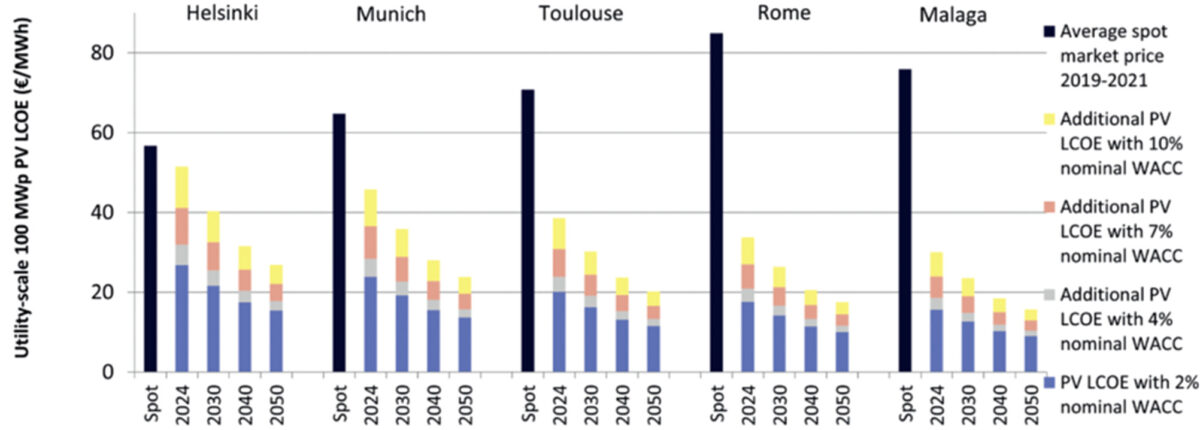The cost of solar photovoltaic systems has decreased dramatically over the past decade. Market prices of PV modules have decreased by about 95% in real terms from 2011. PV has reached parity with retail and wholesale electricity in most countries.
To further analyze the PV market and prices, the European Technology and Innovation Platform for Photovoltaics (ETIP-PV) has recently published its levelized cost of electricity (LCOE) calculations for the period between 2023 and 2050. The LCOE of PV-generated electricity was analyzed for five locations in Europe (Helsinki, Munich, Toulouse, Rome, and Malaga) and four PV system types (residential 5 kW, commercial 50 kW, industrial 1 MW, and utility-scale 100 MW).
The PV LCOE is dependent on the generation cost and includes all the costs involved in supplying PV power at the point of connection to the grid. It is also dependent on the PV system capital (CAPEX) and operational (OPEX) expenditures. The OPEX includes the costs and profit margins of the whole value chain including financing, project development, manufacturing, installation, operation, and maintenance.
For decades, module prices have very closely followed the so-called learning curve, which means that each time the global cumulative PV generation capacity doubles, the price of modules decreases by about 25%. The module prices are expected to decrease according to this historical learning rate (LR) during the next decades, mainly because of better manufacturing processes, more economical use of materials, and continuous improvement in module efficiencies. In addition to an LR of 25%, the calculations also considered an annual inflation of 2%, a system lifetime of 30 years for rooftop systems or 35 years for ground-mounted installations, and an annual degradation of 0.5% in all cases.
Main Findings
According to the base scenario by the ETIP PV, the cumulative global PV capacity would increase from 1.5 TW at the end of 2032 to about 5.5 TW by 2030, and to 30 TW by 2050.
The OPEX for utility-scale is expected to decrease from €12.5 ($13.6)/W/year at the end of 2023 to €9/kW/year in 2050, while for rooftop solar it is €10/kW/year. The CAPEX for utility-scale should fall from €0.46/W at the end of this year to €0.23/W in 2050, while for residential (5 kW), commercial (50 kW), and industrial (1 MW) the prices may reach €0.81, €0.48, and €0.33, respectively. Across all sectors, the CAPEX is roughly halved between January 2024 and 2050.
Compared to current values, the PV LCOE is predicted to decrease by about 20% by 2030, and by 50% by 2050. When comparing with the average wholesale electricity prices of 2019-2021, utility-scale PV would already be competitive with a nominal Weighted Average Cost of Capital (WACC) rate well over 10% in all countries. During the 2022 energy crisis in Europe, spot-market prices were much higher making PV even more competitive.

Image: European Technology and Innovation Platform for Photovoltaics (ETIP PV
The ETIP PV predicts a decline in the LCOE for all locations, with the decline being especially prominent in Rome and Malaga. For instance, in Malaga, the utility-scale PV LCOE, with a 7% nominal WACC, is €24/MWh in 2024, but it is expected to decrease to €19/MWh by 2030 and to €13/MWh by 2050. Nevertheless, the LCOE predictions for all locations are very positive, indicating that PV electricity is already cheaper in all five locations with all realistic WACC rates and consumer segments.
The full LCOE Factsheet that contains all remaining plots for the residential, commercial, and industrial LCOE can be found on ETIP PV’s list of publications. If you want to stay tuned for more information on the ETIP PV’s events and activities, then follow us via our monthly newsletter, our monthly articles at pv magazine, or our LinkedIn channel. Furthermore, if you are interested in working with us, then consider applying to join one of our working groups – we are always actively looking for experts and PV enthusiasts to join our working groups.
The full LCOE Factsheet that contains all remaining plots for the residential, commercial, and industrial LCOE can be found on ETIP PV’s list of publications.
If you want to stay tuned for more information on the ETIP PV’s events and activities, then follow us via our monthly newsletter, our monthly articles at pv magazine, or our LinkedIn channel. Furthermore, if you are interested in working with us, then consider applying to join one of our working groups – we are always actively looking for experts and PV enthusiasts to join our working groups.
The views and opinions expressed in this article are the author’s own, and do not necessarily reflect those held by pv magazine.
This content is protected by copyright and may not be reused. If you want to cooperate with us and would like to reuse some of our content, please contact: editors@pv-magazine.com.



The even better news is that nearly all predictions for the cost of solar have proved to be too conservative, so those figures may well end up overstating the cost of solar by 2030 and 2050. Even the conservative IEA predict global installs of solar by 2030 to be 1 Tw a year, which means that 1.5 Tw is more likely by then.